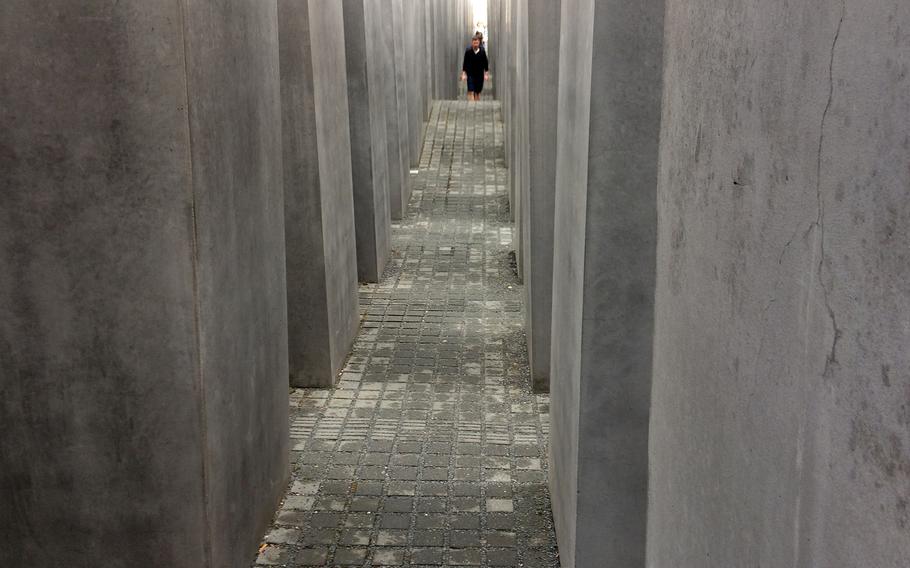
Visitors walk through the Field of Stelae at the Memorial to the Murdered Jews of Europe in Berlin, Germany. The 2,711 stelae are of the same width and length, but of different heights, ranging from about eight inches to over 15 feet. (MICHAEL ABRAMS/STARS AND STRIPES)
On Nov. 9, 1938, the paramilitary Nazi thugs of the Sturmabteilung, or SA, attacked Jewish synagogues and shops across Germany.
Encouraged and helped by the local populace, they went on to destroy much of the Jewish culture and commerce in the country.
Known as Kristallnacht, or Night of Broken Glass — for all of the splintered glass windows — it was the first large-scale incident in what would lead to the death of six million Jews throughout Europe.
To remember the dead, Germany created the Memorial to the Murdered Jews of Europe, in central Berlin near the U.S. embassy.
There was controversy when the plan for the memorial was first announced. It was too big, it was too close to the city center and the Brandenburg gate, and it was just a field of concrete slabs.
How was that supposed to recognize the horrors of the Holocaust?
To their credit, planners didn’t cave to place and size, but they did include a subterranean information center not originally planned by architect Peter Eisenman.
Controversy continued when it was revealed that the slabs, also called stelae, were constructed by a company that had ties to the Nazi war machine.
Today, 13 years later, the memorial is a site — and sight — not to be missed when visiting Berlin.
Despite the kids laughing and playing hide-and-seek, the stelae give one an unsettling feeling. It’s best to walk through the paths between them before heading to the information center.
They are all the same length and width but range from about eight inches to more than 15 feet in height. Walking alone by the tallest of them can leave one disoriented.
The information center is preceded by a line of people, a walk down a flight of stairs and an airport-like security system.
The first room of the exhibit tells the story of Jewish persecution by the Nazis from 1933 to 1945. At the end of the room are six large portraits of Jews lost in the Holocaust, representing the six million who died.
In the “Room of Dimensions,” there are excerpts taken from diaries and letters written by Holocaust victims. One written by Gusta Davidson-Draener reads in part: “You didn’t have to be a revolutionary to put yourself in deadly peril. It was enough simply to be oneself.”
Judith Wishnyatskaya, 12, in a letter to her father on July 12, 1942, writes, “Dear father! I am saying goodbye to you before I die. We would so love to live, but they won’t let us, and we will die.” She and her mother were murdered by the Nazis soon after.
Take time to read as many of them as possible.
The “Room of Families” traces the lives of 15 Jewish families from all over Europe. From simple farmers to a family of printers, their stories are much like the stories of most Jews during this dark period of history. Some survived, most died.
In the “Room of Names,” the names and brief biographies of missing and murdered Jews are read. The names are projected on the walls of the room. According to the information center, it would take six years, seven months and 27 days to read all the names of all the dead and missing.
The “Room of Sites” is chilling.
Here you can see geographically how methodical the Nazi murdering machine was. A large map peppered with little dots show the concentration and death camps the Nazis used for their “final solution.” From the French Atlantic coast to the shores of the Caspian Sea, they systematically tried to wipe out the Jewish people, and in many cases, anyone with distant Jewish lineage.
The final room of the exhibit has photos and information on Jewish memorials throughout Europe.
Climbing the stairs out of the information center seems, at first, like a breath of fresh air, but only until you see the field of stelae in front of you. The impression now, walking through the memorial, is even more unsettling and repressive. It not only makes one think about the tragedy of the murdered Jews of Europe, but of all those who died in Nazi Germany.
And the hope that nothing similar will ever happen again.
DIRECTIONS: The memorial is at Cora-Berliner-Strasse 1, 10117, Berlin, Germany, just south of the Brandenburg Gate and the American embassy.
TIMES: The Information Center is open from 10 a.m. to 7 p.m. Tuesday to Sunday from October to March and from 10 a.m. to 8 p.m. Tuesday to Sunday from April to September. Closed Dec. 24-26 and at 4 p.m. on Dec. 31. Note: The info center will be closed from Nov. 12-19 for renovations. The Field of Stelae is accessible 24 hours a day.
COSTS: Entry to the memorial is free.
INFORMATION: It is frowned upon but permissible to sit on the stelae. Climbing and jumping on them is not allowed.